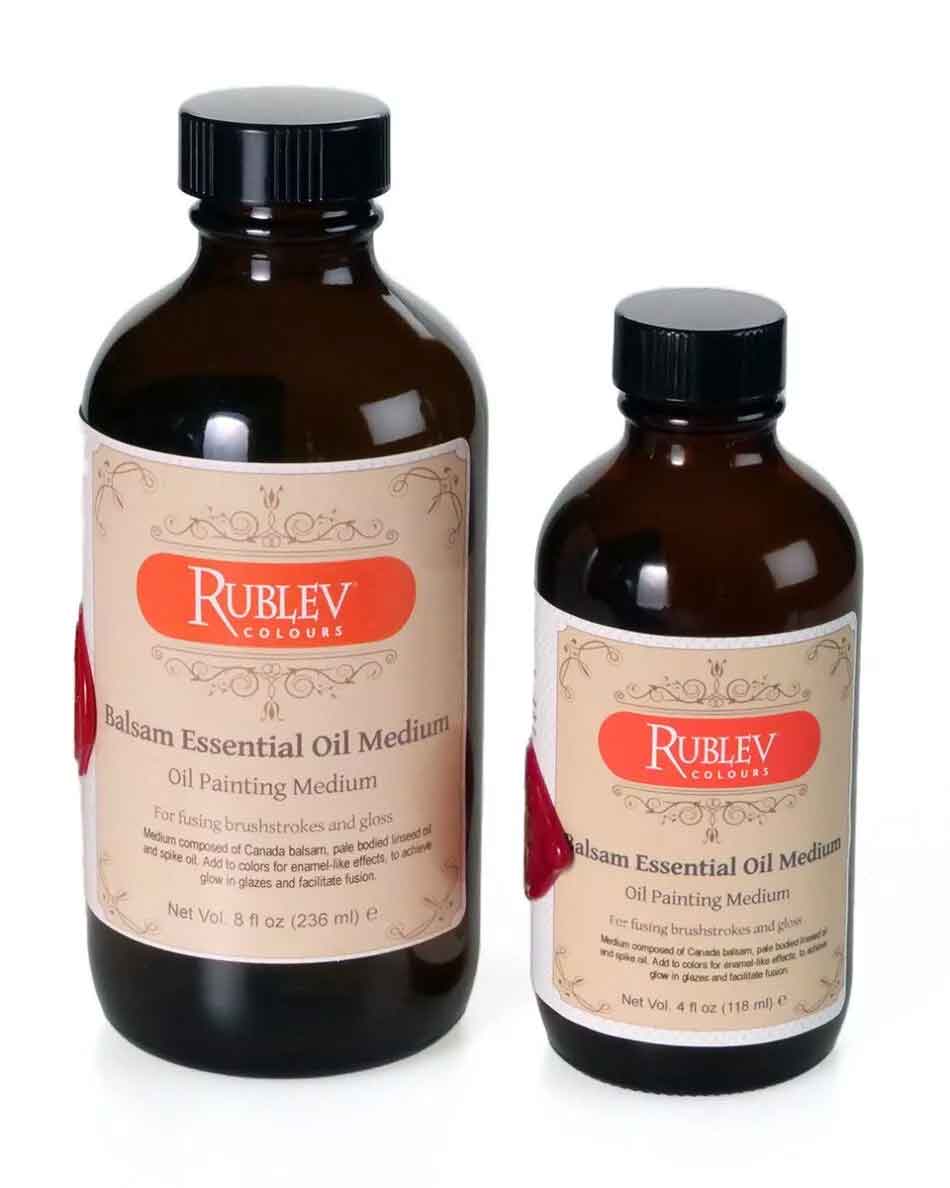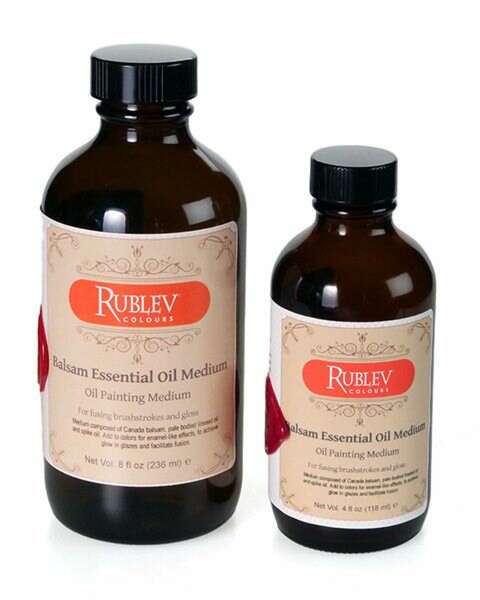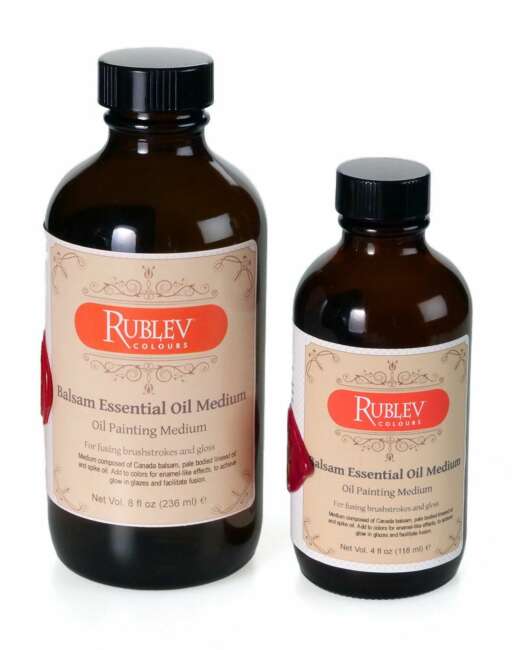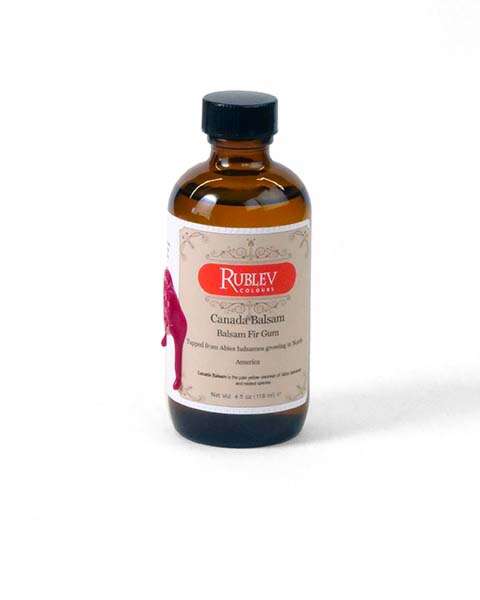
The term ‘balsam’ has been used to designate the resinous exudate from trees of the order Coniferae, which have also been called ‘resin’ or ‘turpentine.’ Balsam is a soft, semi-liquid consisting of terpenes associated with bodies of resinous properties. The balsams most used in varnishes or as paint mediums are Larch balsam (a component of Venice turpentine), Strasbourg turpentine, Canada balsam, and copaiba balsam. Balsams flow easily on a surface and give a lustrous, pleasing quality when applied. However, unless a harder resin is mixed with them, they deteriorate quickly.
For liquid-type oil painting mediums, a mixture of bodied linseed oil, solvent, and, as an option, a resin or balsam can be used in oil painting. Here are several formulas incorporating balsams:
Canada Balsam-Bodied Oil Medium
Ingredients:
3 parts Canada balsam
1 part bodied linseed oil
2 parts gum turpentine
Canada Balsam-Epoxide Oil Medium
Epoxide oil is a dicyclopentadiene copolymer linseed oil. It is a fast-drying oil with good alkali resistance. The copolymer of linseed oil and dicyclopentadiene provides a vehicle that can be added to paints and provides low enough viscosities that make it easy to apply. It is used in this recipe to replace bodied linseed oil.
Ingredients:
3 parts Canada balsam
3 parts Epoxide oil
2 parts gum turpentine
The first formula will dry faster than the second, usually within an hour.
Canada Balsam-Black Oil Medium
Ingredients:
1 part Canada balsam
1 part black oil
1 part spike oil
Combine equal parts Canada balsam, black oil (linseed or walnut heated cooked with litharge or lead(II) oxide), and spike oil. Warm the ingredients to allow the Canada balsam to go into the solution with the other ingredients. Mix a minimal amount into your paint for easier handling and brushing. This mixture promotes interlayer adhesion and dries quickly. Keep covered to avoid excessive evaporation of the spike oil.
About Black Oil
Heating vegetable drying oil with lead salts influences the handling qualities of oil paint and its color. Lead white oil paint is made with oil treated with litharge (lead(II) oxide) or lead acetate yellows more than that oil heated to 300° C without metal salts (Carlyle et al. 2002). This relates to reports in historical sources of the darkening of oil paint (Carlyle 2001b, pp. 23–4, 257–60). Oil painters in the past repeatedly complained of a ‘greasy layer’ that appeared on the surface of their dried oil paint and resisted further applications of paint. This was not confined to nineteenth-century painters (Carlyle 2001b, pp. 205–7, 229): the addition of spike oil to prevent oily skin on the surface of blue oil paint is recommended in the de Mayerne Manuscript (1620–1644: folio 11r). This phenomenon has been observed in paint samples. It is thought to be related to hand-grinding (which requires more oil than machine-grinding) and the lack of suspension agents (such as stearates or hydrogenated castor oil) commonly used in modern paints. As we get closer to approximating historical paint recipes, we encounter technical problems familiar to painters in the past.
Essential-Oil Varnishes
Essential-oil varnishes were used by the Italian and Flemish painters of the fifteenth and later centuries made from fir resins, dissolved by heat, adding an equal quantity of turpentine and petroleum spirit (naphtha), or spike oil, while the resin was in a liquefied state. This made a thin and glossy varnish and was used as a protective covering for the colors in oil painting to make them “hold out” paint films without causing any of the unpleasant darkening effects which are always caused by the use of an oil varnish when applied over a finished picture. Another advantage claimed for this use of an essential-oil varnish was that it permitted a repainting over it when dry, without any danger of cracking the surface. Sometimes concrete Venice turpentine, the balsam product of the larch, was used in making this varnish instead of silver-fir resin (similar in properties to Canada balsam). However, the latter is more transparent and colorless than the former and better than the darker Venetian turpentine.
Canada Balsam-Mastic-Copal Medium
The brilliance of Canada balsam, combined with the rapid drying rate of a soft resin and the hardness of the copal concentrate, produces an excellent painting medium.
Ingredients:
2 parts Canada balsam
2 parts mastic varnish (44% resin w/v solution)
1 part copal varnish (44% resin w/v solution)
1 part vacuum-bodied linseed oil
-
Stir all the ingredients in a double boiler over heat until the balsam combines with the other ingredients.
-
This produces a reasonably heavy medium that can be diluted with turpentine or spike oil.
How to Use:
This medium can be thinned with turpentine and has been used as a final picture varnish—although we do not recommend it as it will yellow. A. P. Laurie suggested that this painting medium closely resembles the characteristics of the medium used by Jan Van Eyck (this has not been substantiated by analysis). This formula dries in about one to two hours.
Canada Balsam-Sun-Thickened Oil Medium
Canada Balsam heightens the gloss of linseed oil and allows a soft fusion of color glazes. Produces brilliant colors in the glazes. Fragrant, viscous, water-clear, and expensive, Canada balsam is worth every penny, for it is unequaled in clarity and drying time.
Ingredients:
1 part Canada balsam
1 part sun-thickened linseed oil
-
Mixed over a double boiler, the heavy-bodied oil and balsam produce a transparent, straw-colored painting and glazing medium which can be safely diluted with turpentine. However, we prefer to use spike oil.
-
Bodied oil may be substituted for sun-thickened linseed oil.
How to Use:
Mix the glaze with tube oil paints or with dry pigments. Apply it in thin coats. Rub it onto the painting with your fingers or with a rag (this is the best way to model smooth transitions in tone). A.P. Laurie spoke highly of Canada balsam, saying it closely resembled the legendary olio d’Arezzo or Strasbourg turpentine. Canada balsam with oil may be used for glazing or painting the last thin coats over oil. A thin coat of this medium dries within 30 minutes. Venice turpentine, although much darker, performs somewhat like Canada balsam. It dries much slower.
Velatura Medium
Velatura derives from the Italian term velatura (singular of velature) can mean sail, veil, or fog in English. In art, it means glaze. Merrifield, in her book, Medieval and Renaissance Treatises on the Arts of Painting, defines velatura as follows:
“When large surfaces were to be glazed, the colour was frequently rubbed on with all the fingers or the flat of the hand, so as to fill the interstices left by the brush, and to cover the surface thinly and evenly….”
Ingredients:
4 parts Italian Varnish
2 parts beeswax
1 part gum turpentine
2 parts vacuum-bodied linseed oil
1 part Canada balsam
This medium gives your paint a translucent quality. The light can still transmit through it and bounce back from the underpainting and primer ground.
Venetian Glazing Medium
Ingredients:
9 parts dammar varnish (5 lb. cut)
9 parts gum turpentine
4 parts vacuum-bodied linseed oil
2 parts Canada balsam
References
Carlyle, Leslie. 2001a. MOLART Fellowship, ‘Historical reconstructions of artist’s oil paint: An investigation of oil processing methods and the use of medium-modifiers,’ Report no. 72894 (revised). Ottawa: Canadian Conservation Institute.
Carlyle, L. 2001b. The Artist’s Assistant: Oil Painting Manuals and Handbooks in Britain 1800–1900 with References to Selected Eighteenth-Century Sources, London: Archetype Publications.
Carlyle, Leslie, Binnie, N., Ruggles, A. and Kaminska, E. 2002. ‘The yellowing/bleaching of oil paintings and oil paint samples, including the effect of oil processing, driers and mediums on the colour of lead white paint,’ in R. Vontobel ed., ICOM-CC 13th Triennial Meeting Preprints, 328–37. London: James & James.
Gettens, Rutherford John; Stout, George Leslie. 1942. Painting Materials: A Short Encyclopaedia, D. Van Nostrand Company, inc., pg. 7.
Merrifield, Mary P. 2012. Medieval and Renaissance Treatises on the Arts of Painting: Original Texts with English Translations, Dover Publications, Inc., 2012, ISBN 0486142248, 9780486142241.
Where to Buy
Shop now for the following items described in this article:












